
* During World War II, the Grumman Aircraft Corporation of Bethpage, New York, became famous for its naval piston-powered combat aircraft -- F4F Wildcat, F6F Hellcat, and TBF Avenger. In the postwar period, Grumman carried on the tradition into the jet age by introducing the "F9F Panther", which performed distinguished service in the Korean War, and which was followed by a swept-wing version, the "Cougar". This document gives a history and description of the Panther and Cougar -- as well as the supersonic Grumman "F11F Tiger" follow-on.
* At the end of World War II, most American aircraft manufacturers had designs for jet aircraft on the drawing boards. Following work on several concepts for pure jet and "mixed power" aircraft with both jet and piston propulsion, engineers at the Grumman Corporation considered a two-seat night fighter, the "G-75", something like the company's F7F Tigercat, but powered by Westinghouse J30 turbojets. Since this engine provided only a feeble 13.4 kN (1,360 kgp / 3,000 lbf) of thrust, the G-75 had four engines, mounted in the wings.
The G-75 lost the competition to the Douglas XF3D-1, which would emerge as the "Skyknight", but as a backup plan the US Navy Bureau of Aeronautics (BuAer) awarded Grumman a contract for two prototypes of the G-75, with the military designation "XF9F-1", on 11 April 1946. As work on the G-75 progressed it was increasingly obvious that it was a loser, but Grumman had also been working on an entirely different concept for a single-seat day fighter, the "G-79". In an intriguing exercise in bureaucratic paperwork, instead of formally canceling the G-75 program and awarding a new contract for the G-79, the G-75 contract was simply amended to specify the G-79, with three prototypes to be built.
Two of the prototypes, to be designated "XF9F-2", were to be powered by a single Rolls-Royce "Nene" centrifugal-flow turbojet engine, with 22.3 kN (2,270 kgp / 5,000 lbf) thrust and mounted in the fuselage. Efforts were underway at the time to arrange license production of the Nene by Pratt & Whitney (P&W) in the US as the "J42". Since the license arrangement hadn't been finalized, as a backup plan the third G-79 prototype, designated "XF9F-3", was to be powered by a similar but less powerful General Electric / Allison J33 engine, with 20.5 kN (2,090 kgp / 4,600 lbf) thrust.
The first XF9F-2 performed its initial flight on 21 November 1947, with Grumman test pilot Corwin H. "Corky" Meyers at the controls. The second prototype flew on 26 November. Both were unarmed. The second prototype crashed during carrier trials on 28 October 1948, but the development program suffered no real delays. The Allison-powered XF9F-3 performed its initial flight on 16 August 1948.
Hedging their bets, Navy brass decided to order both versions of the "Panther", as the new fighter was called, specifying the production of 47 F9F-2s and 54 F9F-3s. The two variants were to be produced in parallel, with the initial production items of both flying in November 1948. However, license construction of the J42 / Nene by P&W was moving forward, rendering the Allison-powered Panther unnecessary, and in fact all the F9F-3s were either completed as or rebuilt to F9F-2 specification.

Initial deliveries of the F9F-2 to service units began in May 1949, and a total of 564 was built, including those that started life as F9F-3s. Underwing stores pylons were added about halfway through production; these Panthers were known using the designation of "F9F-2B" for a time -- until all earlier production was refitted with stores pylons, and then all were simply referred to as F9F-2s.
BACK_TO_TOP* The F9F-2 was of all-metal construction, with a mid-mounted straight wing, tricycle landing gear, and a "stinger"-type arresting hook under the exhaust. The wing featured leading-edge and trailing-edge flaps. The tail assembly was of conventional configuration, with a mid-mounted tailplane. There was a small extensible bumper just ahead of the arresting hook. The main gear hinged in the wings to retract towards the fuselage, while the nosewheel retracted backwards. There was a split perforated airbrake just behind the nosewheel doors. The nose and tail pulled off for maintenance.
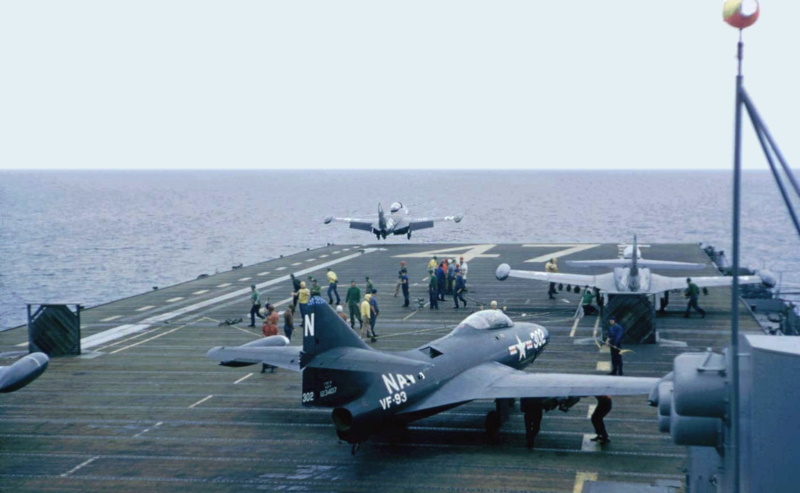
The F9F-2 was powered by a J42-P-8 turbojet with 22.3 kN (2,270 kgp / 5,000 lbf) dry thrust and 25.6 kN (2,605 kgp / 5,750 lbf) boost thrust with water injection; early production had the J42-P-6 with the same thrust, but a different ignition system. The engine intakes were in the wing roots. There were two spring-loaded auxiliary intake doors for takeoff and emergency airflow positioned, somewhat surprisingly, on the spine of the aircraft's midsection.
The wings folded hydraulically upward from just outboard the main gear; oddly, the wing fold angle was well short of the vertical. 455-liter (120 US gallon) fuel tanks were permanently mounted on the wingtips. The tip tanks were not fitted originally to the prototypes, being initially trialed on the first prototype and rolled into manufacturing with the 13th production F9F-2. Including internal tanks and wingtip tanks, total fuel capacity was 3,498 liters (923 US gallons). The pilot sat on an ejection seat in a pressurized cockpit under an all-round vision canopy that slid backwards to open. There was a small step on the lower fuselage that could be slid out to help the pilot get into and out of the aircraft.

The F9F-2 was armed with four 20-millimeter M3 Hispano-type cannon with 190 rounds per gun, fitted under the nose. The guns were aimed by a Mark 8 computing optical gunsight. The F9F-2 had no radar. It had four stores pylons under each wing, with a heavy pylon inboard and three lighter pylons outboard, for a total of eight pylons. The large pylon could handle up to a 450-kilogram (1,000-pound) bomb and was "wet", allowing carriage of a 568-liter (150 US gallon) drop tank. The outer wing pylons could each carry up to a 125-kilogram (250-pound) bomb or a 12.7-centimeter (5-inch) "high velocity aircraft rocket (HVAR)"; it doesn't seem that HVARs were ever carried on the large pylon, possibly because they were too close to the intakes and rocket exhaust ingestion might have caused engine stalls. Total external load was 900 kilograms (2,000 pounds) -- though in practice, the F9F-2 was too underpowered to take off from a carrier deck with anything resembling a full combat load. An improved engine was clearly needed.
Although the prototypes had flown in natural metal finish, production machines were painted in overall dark sea blue, the standard US Navy and Marine color scheme of the day. Colorful trim was added as desired by various squadrons.
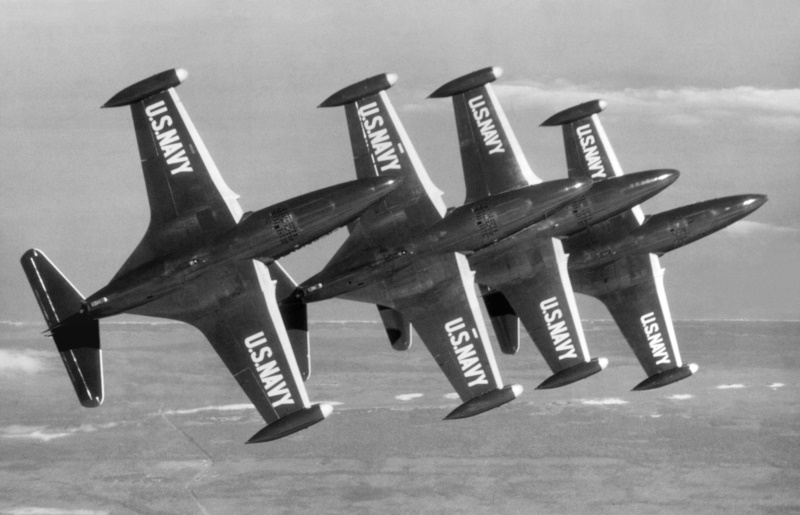
* The F9F-2 was the first US Navy jet to go into combat, performing airstrikes in support of UN forces fighting in Korea on 3 July 1950. The Panther would score its first "kill" on 3 July 1950, when Ensign E.W. Brown and LTJG L.H. Plog shared credit for the destruction of a Yakovlev Yak-9 piston-powered fighter. On 9 November 1950, Lieutenant Commander Tom Amen claimed the destruction of a Russian-built, Russian-piloted Mikoyan MiG-15 fighter, the US Navy's first jet-on-jet kill.
The Panther was not generally the equal of the faster MiG-15 in performance and was mostly used in the attack role, but like its Grumman ancestors it was extremely rugged, able to both dish out and take punishment. It became the most heavily used jet fighter of the Navy and Marines during in the war. It also became the mount of the US Navy "Blue Angels" flight demonstration team in 1949, replacing Grumman F8F-1 Bearcats and becoming the first jet flown by the Angels.
A number of F9F-2s were field-modified by the Navy to a photo-reconnaissance configuration as a "stopgap solution", seeing service in Korea. These machines had no cannon, the nose carrying a suite of vertical and oblique cameras instead, and were designated "F9F-2P". They served through most of the war, operating as a complement to McDonnell F2H-2P Banshee photographic reconnaissance machines.
BACK_TO_TOP* The Navy liked the F9F-2 enough to obtain improved Panthers. 73 "F9F-4s" with the Allison J33-A-16 turbojet were ordered, with the engine providing 27.8 kN (2,835 kgp / 6,250 lbf) dry thrust and 30.9 kN (3,150 kgp / 6,950 lbf) boost thrust with water injection. The F95-4 also featured:
The F9F-4 prototype was converted from a production F9F-2 and performed its initial flight on 5 July 1950. 109 production F9F-4s were built and the Marines operated at least one squadron in Korea, but the Allison engine was unreliable, and many of these were converted to the "F9F-5" configuration.
* The F9F-5 was effectively an F9F-4 with the stretched fuselage, taller tailfin, and so on, but with an improved derivative of the Nene turbojet, known as the Rolls-Royce "Tay" and built under license by P&W as the "J48", instead of the Allison J33-A-16. The J48-P-6 engine fitted to the F9F-5 provided 27.8 kN (2,835 kgp / 6,250 lbf) dry thrust and 31.1 kN (3,175 kgp / 7,000 lbf) wet thrust. (Some sources hint that the Tay / J48 had afterburning, but this claim is hard to confirm.)
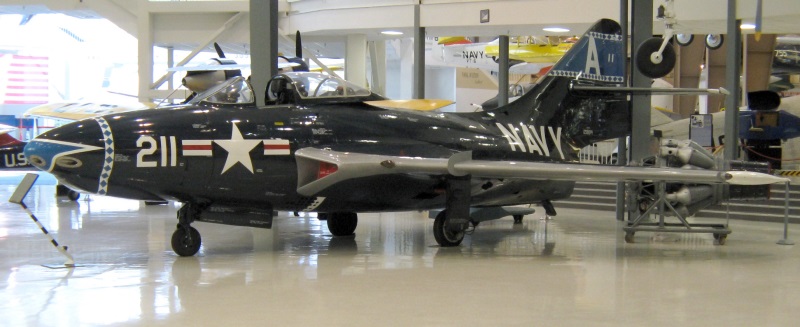
The initial prototype F9F-5, a converted production F9F-2, performed its first flight on 21 December 1949, with deliveries to the Navy and Marines beginning in November 1950. The F9F-5 generally replaced the relatively underpowered F9F-2 in service, and went into combat in Korea in late 1952. The Blue Angels had already upgraded to the F9F-5 about a year earlier, in late 1951.
___________________________________________________________________
GRUMMAN F9F-5 PANTHER:
___________________________________________________________________
wing area:
23.2 sq_meters (250 sq_feet)
length:
11.83 meters (38 feet 10 inches)
height:
3.73 meters (12 feet 3 inches)
empty weight:
4,600 kilograms (10,150 pounds)
loaded weight:
8,500 kilograms (18,720 pounds)
max speed at altitude:
1,005 KPH (625 MPH / 545 KT)
service ceiling:
13,000 meters (42,650 feet)
range:
2,090 kilometers (1,300 MI / 1,130 NMI)
___________________________________________________________________
A total of 616 F9F-5s was built, not counting F9F-4 conversions. Some F9F-5s were delivered in anodized aluminum finish as something of an experiment, but the metal didn't hold up against corrosion, and Panthers went back to glossy sea blue.
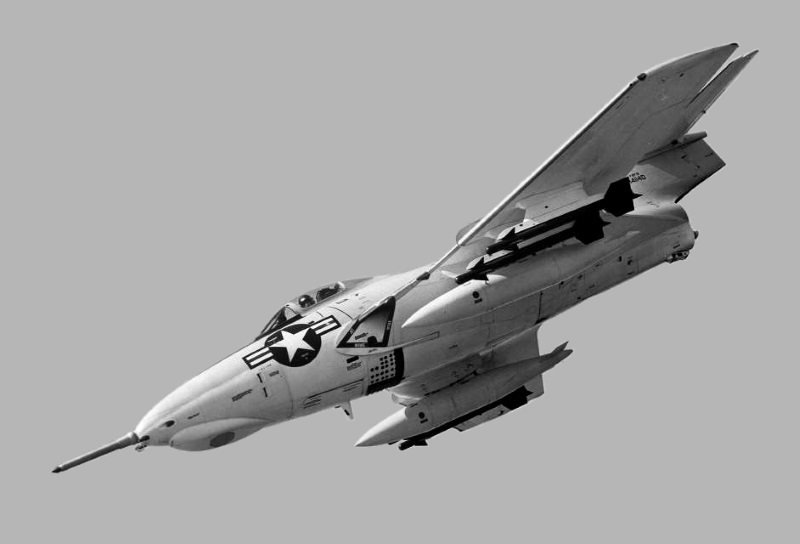
A total of 36 "F9F-5P" unarmed photo-reconnaissance machines was built as well. The cannon were removed and replaced by vertical and oblique cameras. The modified nose stretched the length of the aircraft by 37 centimeters (14.6 inches) to 12.2 meters (40 feet). The F9F-9P also included an autopilot to provide stability during photoshoots.
The F9F-5 saw plenty of combat -- including one incident on 18 November 1952, when one Lieutenant Royce Williams, operating off the USS ORISKANY, was attacked by seven MiG-15s. After a grueling extended dogfight, he shot down at least four of them. His F9F-5 was so shot up after it landed on the ORISKANY that it had to be pushed over the side. The incident was kept quiet to keep from provoking the Soviets.
* The Panther was quickly relegated to Reserve service after the Korean War, lingering on late into the decade. Some Panthers were modified as target drones and designated "F9F-2D" or "F9F-5D" as appropriate, with others modified as drone controllers and designated "F9F-2KD" or "F9F-5KD" as appropriate; the drones remained in service into the early 1960s. The only way to tell them from conventional Panthers was by the presence of a set of blade antennas on the nose. There were a number of other conversions of Panthers:
Panthers were also used for armament trials. A picture survives of an F9F-5 at the naval weapons test center at China Lake in California carrying four pods of four 12.7-centimeter Zuni rockets, for a total warload of 16 rockets -- a formidable punch in the attack role.
* The only foreign user of the Panther was Argentina, which received 24 refurbished F9F-2s in 1958. They were operated by the Argentine Navy from ground bases. Four were destroyed on the ground in a 1963 coup that put the army and navy at odds. The survivors performed border patrols in 1965 during a period of troubles with Chile. All were grounded due to lack of spares in 1969.
BACK_TO_TOP* At the outset of the F9F program, the Navy had pressed Grumman to consider a swept-wing version, but in the face of inexperience with swept-wing aerodynamics at the time, the company's engineers were uncertain of how to proceed; the swept-wing F9F stayed on the back burner for the time being. The Korean War and the MiG-15 brought it to the front burner, and in March 1951 the US Navy awarded Grumman a contract for a swept-wing F9F, which was given the company model number of "G-93".
Three F9F-5s were modified on the production line as G-93 prototypes, with two of these machines being flight prototypes and the third a static test airframe. The program moved along quickly, the F9F-5 being a mature aircraft and much having been learned about swept wings in the previous few years. The initial flight of the "F9F-6" was on 20 September 1951, with Grumman test pilot Fred C. Rowley at the controls.
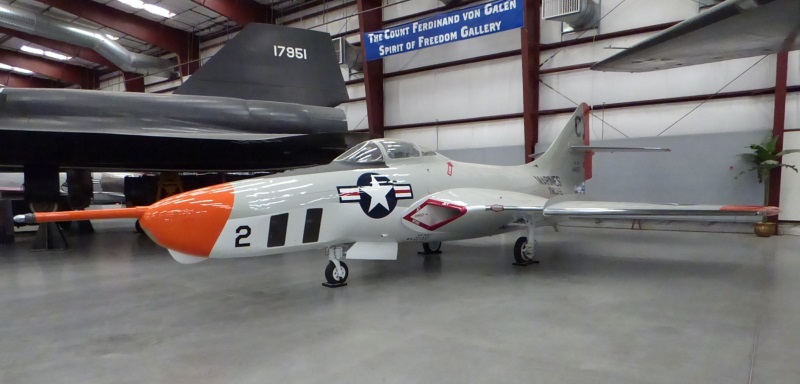
The new variant was different enough from the F9F-5 to be given a new name: "Cougar". The Cougar featured a wide range of improvements:
The Cougar retained other elements of the Panther, such as the quad 20 millimeter cannon and J48 engine. Although early Cougar production was fitted with the J48-P-6A variant, which was the same as the J48-P-6 with some fixes, later F9F-6 production featured the J48-P-8, with a max thrust of 32.2 kN (3,290 kgp / 7,250 lbf).
___________________________________________________________________
GRUMMAN F9F-8 COUGAR:
___________________________________________________________________
wingspan:
10.52 meters (34 feet 6 inches)
wing area:
31.31 sq_meters (337 sq_feet)
length:
12.73 meters (41 feet 9 inches)
height:
3.73 meters (12 feet 3 inches)
empty weight:
5,380 kilograms (11,860 pounds)
loaded weight:
11,230 kilograms (24,760 pounds)
max speed at altitude:
1,040 KPH (645 MPH / 560 KT)
service ceiling:
15,240 meters (50,000 feet)
range:
1,690 kilometers (1,050 MI / 915 NMI)
___________________________________________________________________
Initial service deliveries were in late 1952. Pilots were delighted with the improved performance of the Cougar, and surprisingly it turned out to have better carrier handling than the Panther. No doubt Navy and Marine pilots were eager to take on MiG-15s with a machine that could fight on more equal terms -- but the Cougar didn't reach combat before the war ended in July 1953.
646 F9F-6 Cougars were built to 1954. They were delivered in classic Navy overall sea blue colors, but generally updated to the new standard of gull gray on top and white on the bottom. Many were refitted in service with a UHF direction finder in a fairing under the nose, and some were fitted with a nose inflight refueling probe. On 1 April 1954, three probe-equipped F9F-6s set a transcontinental speed record by flying coast-to-coast in under four hours, the best time being 3:45:30 for a distance of 3,925 kilometers (2,438 miles).

* A total of 60 "F9F-6P" unarmed photo-reconnaissance machines with a camera nose and no cannon was built in 1954 and 1955. The camera nose stretched the aircraft by 22 centimeters (9 inches) to 12.86 meters (42 feet 2 inches). Some were refitted with nose inflight refueling probes.
They were followed by 168 "F9F-7s" with the Allison J33-A-16A engine. As with the F9F-4, the Allison engine proved unreliable, and 50 of these machines were delivered with the J48 engine, making them indistinguishable from F9F-6s. Most F9F-7s that were delivered with the Allison engine were refitted with the J48 as well.
The final single-seat fighter version of the Cougar, the "F9F-8", was introduced in 1954. It featured a 20 centimeter (8 inch) fuselage stretch with a larger fuselage fuel tank; a reinforced canopy; and a redesigned wing, with greater area and reduced thickness to improve handling and provide more wing fuel tankage. Fuel capacity was increased to a total of 4,029 liters (1,063 US gallons). The F9F-8 was powered by a J48-P-8A or J48-P-8C engine, with the same thrust as the J48-P-8, but with some minor improvements.

A total of 601 F9F-8s was built from 1954 to 1957. Late production was fitted with a nose inflight refueling probe; it appears that earlier production was refitted with the probe as well, and that the F9F-8 was also refitted with the UHF homing system in an undernose fairing. Late production F9F-8s could also carry four Sidewinder air-to-air missiles (AAM), two under each wing, and some earlier production was refitted with Sidewinder capability as well.
The Blue Angels traded in their F9F-5 Panthers for F9F-8 Cougars in 1954; they had been handed F9F-6s in 1953, but demand for the Cougar at the time was intense, and they were promptly grabbed for operational service. The Angels flew the F9F-8 up to 1957, when it was replaced with the Grumman F-11F Tiger.
A number of F9F-8s were modified as "F9F-8B" tactical nuclear bombers, fitted with a "Low Altitude Bombing System (LABS)". A total of 110 "F9F-8P" unarmed reconnaissance machines with a swollen "duck's bill" camera nose were built as well. They could be fitted with a nose refueling probe.

The last production version of the Cougar was the "G-105" or "F9F-8T", a tandem-seat trainer. It featured a fuselage stretch of 86.4 centimeters (34 inches) and a single rearward-sliding canopy. There was a windscreen between the cadet pilot's seat in front and the instructor's seat in back; armament was reduced to two cannon. Initial flight of the F9F-8T was on 4 April 1956. The US Navy had planned to adopt a navalized version of the Lockheed T-33 trainer, the "T2V-1 Sea Star", and had initially not been very interested in the F9F-8T. However, the Sea Star program ran into troubles and the F9F-8T began to seem more attractive, with the Navy obtaining a total of 399 F9F-8Ts.
Most F9F-8Ts were refitted with a nose refueling probe, and some were wired for Sidewinder AAMs, though in fact they rarely carried them. A night-fighter version with AAM armament was considered but not adopted, and an improved trainer with a P&W J52 turbojet was also considered but rejected.
* The Cougar was regarded as a fine aircraft, very rugged and reliable, with excellent handling. Aircraft design was moving very rapidly in the 1950s, however, and Cougar fighters were out of first-line service by the end of the decade. They lingered in Reserve service into the mid-1960s. After retirement from squadron service, Cougars were used as drones -- including the "F9F-6K", "F9F-6K2", and "F9F-8K" -- and drone directors -- including the "F9F-6D", "F9F-6PD", and "F9F-8D".
The US military services adopted a uniform aircraft designation system in 1962, and such F9Fs as were still in operation at the time were redesignated as follows:
The F9F-8T / TF-9J remained in training service into 1974. Four were flown in Vietnam on fast spotter missions. A number of Cougars remain on static display, but it doesn't appear any are flying any longer.

* As with the Panther, a number of Cougars were used for test and trials:
The only foreign user of the Cougar was once again Argentina, which obtained two hand-me-down US Navy F9F-8Ts in 1962. They were withdrawn from service in 1971.
The following list summarizes F9F variants and production:
Total Cougar production was 1,984 aircraft, with 3,313 Panthers and Cougars manufactured in all. A number of Panthers and Cougars remain on static display, but it doesn't appear any are flying any longer.
BACK_TO_TOP* In 1952, Grumman engineers conducted a study to determine if the performance of the Cougar might be improved by adding "area ruling" -- a scheme in which changes in the cross-section of an aircraft were minimized, resulting in a bulged or "wasp-waisted" fuselage rear of the wings. Area ruling reduced transonic drag and, it was hoped, would help give the Cougar supersonic performance. The project was given the company designation of "G-98".
As the investigation proceeded, the idea of simply modifying the Cougar proved impractical. By the spring of 1953, the G-98 had evolved into an entirely new design, with a slender fuselage featuring area ruling, all-swept flight surfaces, and side-mounted engine intakes. The engine was to be an afterburning Wright J65 turbojet, a license-built version of the British Armstrong-Siddeley Sapphire engine.
The Navy BuAer liked the proposal, and awarded a contract to Grumman in April 1953 for two flight prototypes and a static-test airframe. The G-98 prototypes were to be originally designated "XF9F-8" and then "XF9F-9", even though they had nothing in common with the Cougar.
Tests were performed of the G-98 design using a rocket-boosted scale model, and even a model mounted on the nose boom of an F9F-6 Cougar. Results were good enough to persuade the Navy to order 42 evaluation / initial production machines, though the first prototype hadn't flown at the time. The initial prototype of the XF9F-9 performed its first flight on 30 July 1954, with Corky Meyers at the controls. Since an afterburning Wright J65 engine wasn't available at the time, the first prototype was fitted with a non-afterburning J65-W-7 engine providing 33.4 kN (3,400 kgp / 7,500 lbf) thrust. Despite the non-afterburning engine, performance was excellent, nudging a top speed of Mach 1.
The second prototype performed its initial flight on 2 October 1954, also being (initially) fitted with a non-afterburning Wright J65 engine. The timing was fortunate, since the first prototype crashed near the Grumman plant on Long Island on 20 October 1954, with the pilot, Lieutenant Commander W.H. Livingston, ejecting safely. The second prototype was transferred to Edwards Air Force Base (AFB) in California for further trials, where it was fitted with an afterburning J65, which permitted it to break Mach 1 in level flight. This was not, however, the first Navy fighter to achieve that distinction, the Douglas Skyray having broken Mach 1 in level flight in June 1954.
The flight tests did demonstrate some problems that dictated changes. The first evaluation / initial production machine, which performed its first flight on 15 December 1954, featured a redesigned tailfin, modified engine intakes, an improved canopy, and a slightly longer nose. With the changes, the Navy judged the machine worthy of full production, ordering another 388 fighters, plus 85 reconnaissance machines.
In April 1955, the Navy finally conceded that the Tiger wasn't really an improved Cougar; the fighter was redesignated the "F11F-1", with the reconnaissance machines designated "F11F-1P". In keeping with the tradition of naming Grumman fighters after members of the cat family, the new aircraft was named the "Tiger". Carrier trials began a year later, with initial service deliveries following soon after, the first machines being accepted by Navy squadron VA-156 -- a fighter outfit, despite its "A" for "attack" designation -- in March 1957.
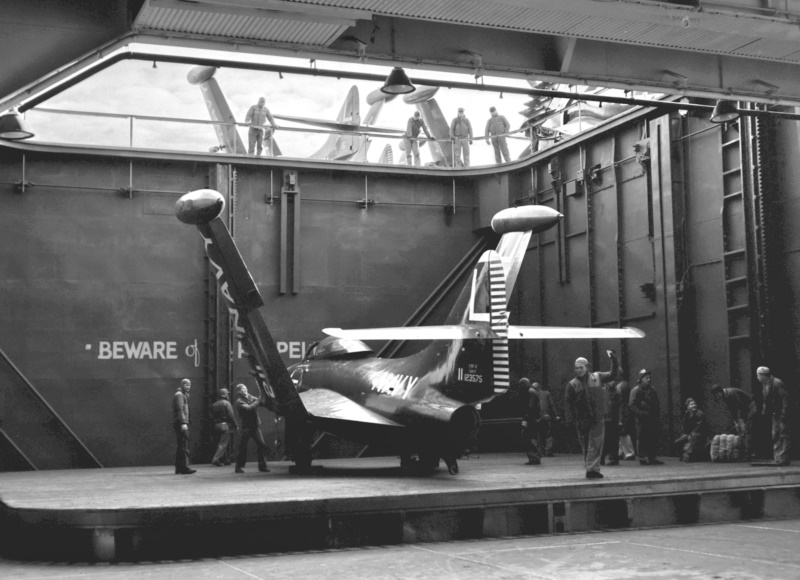
* The Grumman Tiger was, as mentioned, a single-engine aircraft with mid-mounted swept wings and a swept tail assembly. The wings featured a sweep of 35 degrees, leading-edge slats, plus full-span trailing-edge flaps, with spoilers replacing ailerons. A fence was fitted to the wing at about one-third span, and the wingtips folded up for carrier stowage. The tailplane was "all moving", though it retained elevators.
The pilot sat on an ejection seat under a rearward-sliding canopy. The tricycle landing gear included a twin-wheel nose gear that retracted backwards and single-wheel main gear that pivoted from the wings into the fuselage. A stinger arresting hook was fitted, as well as a retractable tail bumper.
The Tiger was powered by a Wright J65-W-18 turbojet, providing 32.9 kN (3,355 kgp / 7,400 lbf) dry thrust and 46.7 kN (4,760 kgp / 10,500 lbf) afterburning thrust. The engine was fed through fixed "dee" type inlets alongside the fuselage rear of the cockpit, with a "splitter plate" forward of each inlet to prevent the engine from ingesting stagnant "boundary layer" air. Internal fuel capacity was 3,464 liters (914 US gallons), and a retractable inflight refueling probe was fitted alongside the nose.
Armament consisted of four 20-millimeter cannon mounted under the engine intakes. There were four stores pylons, capable of carrying either four Sidewinder AAMs, or two Sidewinders and two external tanks with a fuel capacity of 568 liters (150 US gallons) each. Bombs and unguided rocket pods were qualified as well, but rarely if ever carried in service.
___________________________________________________________________
GRUMMAN F11F-1 TIGER:
___________________________________________________________________
wingspan:
9.64 meters (31 feet 8 inches)
wing area:
23.23 sq_meters (250 sq_feet)
length:
14.3 meters (46 feet 11 inches)
height:
4.04 meters (13 feet 3 inches)
empty weight:
6,500 kilograms (14,330 pounds)
MTO weight:
10,920 kilograms (20,075 pounds)
max speed at sea level:
1,210 KPH (750 MPH / 655 KT)
service ceiling:
12,770 meters (41,900 feet)
range:
2,050 kilometers (1,275 MI / 1,110 NMI)
___________________________________________________________________
* From the 58th production machine on, the fuel capacity was increased with additional fuel cells in the intake walls and tailfin, raising total capacity to 3,976 liters (1,049 US gallons). Later production machines also had leading-edge wingroot fillets and a longer nose -- in principle to accommodate an AN/APS-50 radar set, though it was never fitted operationally. The refueling probe was moved from the left to the right side of the nose.
Only 142 aircraft were built in the second production batch. The Navy was obtaining the Vought F8U Crusader at the time and it proved superior to the Tiger in most respects, in particular with much better climb rate and high-altitude performance. Reliability of the Tiger's J65 engine was also unsatisfactory. Further production of the Tiger was canceled, with none of the F11F-1P reconnaissance machines ever actually built. The last Tiger was rolled out in early 1959.
The Tiger's life in frontline fleet service was correspondingly short. It flew off the carriers USS BON HOMME RICHARD, FORRESTAL, INTREPID, RANGER, and SARATOGA, but all Tigers had been passed off to training and other roles by the spring of 1961, to be redesignated "F-11A" when the tri-service designation scheme was adopted in 1962. The Tiger was phased out of training service in 1967.

The Tiger never saw combat, but it did have the distinction of service as a mount for the Navy Blue Angels flight demonstration team. The team acquired early-production short-nosed Tigers in the spring of 1957, later trading them in for long-nosed Tigers. The Blue Angel Tigers were among the last of the breed to fly in Navy service, being finally traded in for McDonnell F-4J Phantoms in 1969. It seems a bit unusual for the Angels to have been flying aircraft no longer otherwise in Navy service -- but it is plausible that demands of the war in Vietnam meant that first-line aircraft had to be committed to the combat zone.
That was not quite the final flight service of the Tiger. In 1973, two of the Blue Angels F-11As were pulled from the "boneyard" at Davis-Monthan Air Force Base in Arizona, with one fitted with a thrust reverser for trials, and the other used as a chase plane. They were sent back to the boneyard in 1975. A number of Tigers survive as static displays, but none remain in flying condition.

* There were plans for an improved Tiger or "Super Tiger" even before the F11F-1 entered fleet service. Grumman considered a Tiger with a General Electric (GE) J73 turbojet and a Tiger with a wing featuring a sweep of 45 degrees. These studies went nowhere, but a concept for a "G-98J" with a GE J79 afterburning turbojet appealed to the Navy, which in 1955 ordered the last two machines in the initial "short-nosed" Tiger production batch to be fitted with a GE YJ79-GE-3 turbojet with 42.7 kN (4,350 kgp / 9,600 lbf) dry thrust and 66.7 kN (6,800 kgp / 15,000 lbf) afterburning thrust.
These two machines were designated "F11F-2" and were generally similar to stock F11F-1s, except for larger engine intakes to handle the greater airflow. Initial flight of the F11F-2 was on 25 May 1956, with the machine attaining Mach 1.44 ten days later, even though it was fitted with a preproduction J79 with a lower thrust rating. The prototype was then fitted with a fully-rated J79, as well as wingroot fillets and a 34.3 centimeter (13.5 inch) rear fuselage extension. It quickly broke Mach 2, and then set a world altitude record on a dash climb to 24,465 meters (80,250 feet).
The Navy didn't feel like the F11F-2 was particularly attractive relative to the Crusader, and decided not to place a production order. The designation of the prototypes was then changed to "F11F-1F". However, a number of NATO nations and Japan were interested in obtaining a modern Mach 2 jet fighter, performing flight evaluations of the Super Tiger to see if it fit the bill -- though one of the two machines was damaged beyond repair in a take-off accident on 23 June 1958. In the end, the Lockheed F-104 Starfighter won the competition. The sole surviving Super Tiger ended up on display at the US Naval Museum of Armament & Technology at China Lake in California.
BACK_TO_TOP* Sources include:
This document owes much to an online document on the Panther / Cougar by aviation enthusiast Joe Baugher.

* Illustrations details:
* Revision history:
v1.0.0 / 01 oct 07 v1.0.1 / 01 sep 09 / Minor corrections. v1.0.2 / 01 aug 11 / Review & polish. v1.0.3 / 01 jul 13 / Review & polish. v1.0.4 / 01 apr 15 / Review & polish. v1.0.5 / 01 mar 17 / Review & polish. v1.0.6 / 01 may 18 / Review & polish. v1.0.7 / 01 mar 20 / Review & polish. v1.0.8 / 01 oct 21 / Review & polish. v1.1.0 / 01 jan 22 / Folded in Grumman Tiger. v1.1.1 / 01 mar 23 / Review & polish. v1.2.0 / 01 feb 25 / Added drawings. (+)BACK_TO_TOP
